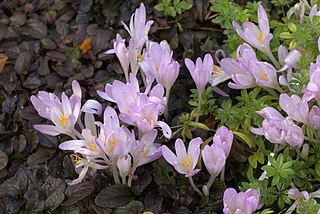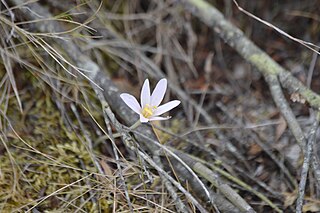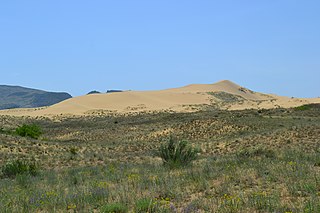
Colchicum is a genus of perennial flowering plants containing around 160 species which grow from bulb-like corms. It is a member of the botanical family Colchicaceae, and is native to West Asia, Europe, parts of the Mediterranean coast, down the East African coast to South Africa and the Western Cape. In this genus, the ovary of the flower is underground. As a consequence, the styles are extremely long in proportion, often more than 10 cm (4 in). All species in the genus are toxic.

Colchicine is a medication used to treat gout and Behçet's disease. In gout, it is less preferred to NSAIDs or steroids. Other uses for colchicine include the management of pericarditis and familial Mediterranean fever. Colchicine is taken by mouth.

Colchicum autumnale, commonly known as autumn crocus, meadow saffron or naked ladies, is a toxic autumn-blooming flowering plant that resembles the true crocuses, but is a member of the plant family Colchicaceae, unlike the true crocuses which belong to the family Iridaceae. The name "naked ladies" comes from the fact that the flowers emerge from the ground long before the leaves appear. Despite the vernacular name of "meadow saffron", this plant is not the source of saffron, which is obtained from the saffron crocus, Crocus sativus – and that plant too is sometimes called "autumn crocus".

Myoporum laetum, commonly known as ngaio or mousehole tree is a plant in the family Scrophulariaceae endemic to New Zealand, including the Chatham Islands. It is a fast growing shrub, readily distinguished from others in the genus by the transparent dots in the leaves which are visible when held to a light.

Colchicum trigynum is a species of plant native to Turkey, Iran and the Caucasus, often grown as an ornamental plant outside its native range.

Colchicum × agrippinum is a species of flowering plant in the family Colchicaceae. It is considered to be a hybrid between C. variegatum and C. autumnale, and not a true species, although this is not certain. The genus and the species are commonly called autumn crocus, naked lady or meadow saffron.

Colchicum davisii is a large-flowering plant species native to Turkey. The flowers are very pale pink and heavily tessellated with a white throat and prominent yellow anthers. They are produced in autumn. The corms, are elongated and have several growing points.
Colchicum atropurpureum is a small flowered Colchicum which has blooms that open pink and then turn to a darker shade of red-purple. This plant is often confused with Colchicum autumnale. It is considered unresolved, or species inquirenda, according to The Plant List.

Colchicum × byzantinum, the Byzantine meadow saffron, is a species of flowering plant in the family Colchicaceae with a long history of cultivation, and no certain place of origin. It is thought to be a hybrid of other species.

Colchicum corsicum is a species of flowering plant in the Colchicaceae family. It is native to the islands of Corsica and Sardinia in the Mediterranean.

Colchicum kotschyi is a species of flowering plant in the Colchicaceae family. It is native to Iran, Iraq and Turkey. It blooms relatively early for an autumn flowering colchicum, as early as August. The flowers open to a pink-purple colour, but white flowered specimens are common in the wild. The plant reaches up to 2 m (6") tall and grows well in sunny, warm locations.
Colchicum baytopiorum is a plant species native to western Turkey and to the Greek Island of Rhodes. It has small, bright pink-purple flowers measuring 4 cm (1.5") across. It is unusual in the genus in producing small leaves in autumn while in bloom, as opposed to producing leaves in spring. It has a chromosome number of 46, 54 or 108. The species was named in honor of Turkish botanist Asuman Baytop.

Colchicum boisseri is member of the flowering plant family Colchicaceae native to southern Greece and south-western Turkey but cultivated elsewhere as an ornamental. The species is unique for its spreading, rhizomatous bulbs. It blooms well with 5 cm (2") blooms in a bright cherry pink. The stamens are yellow. The flowers have no tessellations, only a white line down the centre of each petal. It is named after botanist Pierre Edmond Boissier.

Colchicum cupanii is a widespread species of flowering plant in the family Colchicaceae, known as the Mediterranean meadow saffron. It grows around much of the central Mediterranean Basin, reported from France, Sardinia, Italy, Albania, Greece, Montenegro, Croatia, Sicily, Algeria, Malta and Tunisia.
Colchicum lingulatum is a species of flowering plant in the Colchicaceae family. It is native to north-western Turkey and to Greece.
Colchicum parlatoris is a small species of flowering plant native to Greece. It has dark-purple pink flowers on short stems bearing prominent yellow stamens. The species is very similar to Colchicum pusillum.
Colchicum parnassicum is a plant species endemic to the Sterea Ellada region of central Greece. It is closely related to Colchicum autumnale, mainly being different in having shorter flowers. The blooms are produced in fall and have a medium pink colour. The flowers hold up well in fall weather. This species, if cultivated in cold climates, it will do better in a sunny, sheltered location.
Colchicum zahnii is a member of the flowering plant family Colchicaceae that is native to southern Greece. It blooms in mid-fall from rhizomatous corms. The flowers can be variable colored, being a pale purple-pink to white and are often held wide open. The leaves are produced at flowering time and usually number 2 to 3. This species is similar to Colchicum boissieri in that the corms grow into large patches, rather than tight clumps like Colchicum speciosum or Colchicum autumnale.

Colchicum bulbocodium, the spring meadow saffron, is a species of alpine bulbous plant native to mountain ranges across Europe from the Pyrenees to the Caucasus.

Sarykum or Sary-Kum is a large sand dune located in the Kumtorkalinsky District of Dagestan, Russian Federation. It is one of the largest sand dunes in Eurasia. The dune is located in a protected area, part of the Dagestan Nature Reserve, which was established on 9 January 1987.














